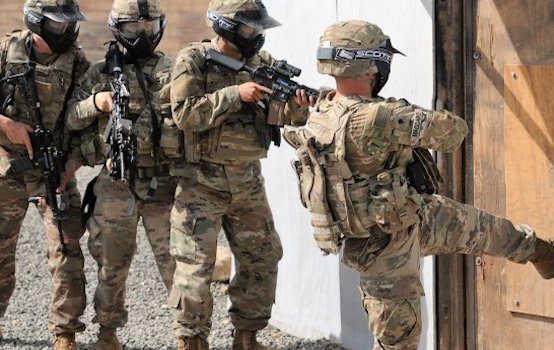Why Do We Fight? How Do We Fight?

Today’s political and military leaders have no choice but to project technology and strategic conditions into the future while they develop their forces today. However, before such multi-billion dollar investments are made, critical questions should be answered.
What is the real mission set? In other words, whom do we fight? Where do we fight? How do we fight? And how do we get there? On Memorial Day, we must take a step back to properly address these questions because right now it’s not so clear. What we do have is a military spending strategy that is out of whack with reality and setting us up for failure when real threats arise.
The United States is primarily a global maritime and aerospace power, not a global land power. Washington is known for exaggerating threats, but is the notion of spending to fight a near-simultaneous war with Russia and China in 2030 a realistic goal? Wars with continental powers like Russia, China, or even Turkey or Iran, demand the persistent employment of large and powerful ground forces projected over thousands of miles. U.S. military advantages at sea and in the air are relegated to supporting roles as seen in World War II, Korea, and Vietnam.
Long before U.S. forces entered World War II in 1942, the British Empire and the Soviet Union fought for years and sustained millions of casualties. Who are Washington’s allies today? How many field capable forces would be able to assist us in the field? How many are just military protectorates seeking to shift the burden of their defense to Washington?
Throughout the 20th century, strong majorities of Americans opposed involvement in all wars overseas. President John F. Kennedy’s statement that Americans “would pay any price, bear any burden…oppose any foe in order to assure the survival and success of liberty,” was false the moment JFK made it.
The answers to the questions above should align the structure and use of U.S. military power with strategic, technological, and fiscal realities. But in the senior ranks of the armed forces—especially in the U.S. Army and Marines—aligning military power with reality is sacrificed to the protection of “service equities,” meaning warfighting structures, equipment sets, and missions from unwanted changes in warfare wrought by technology.
As Under Secretary of the Navy, Robert Work identified the problem in the context of future amphibious operations: “The Navy-Marine team will never contemplate littoral maneuver until an enemy’s battle network, capable of firing dense salvos of guided weapons, is suppressed…Thus far we have only argued that some capability to conduct theater-entry operations and littoral maneuver must be retained. But it is fair to ask how much amphibious capacity is needed.”
In other words, the Marine Corps’ slow, soft-skinned, virtually defenseless amphibious carriers, auxiliaries, and VTOL/STOL airlift with their fragile cargoes of Marines cannot operate against the Chinese until the U.S. Air Force and Navy eliminate China’s air and naval forces from most of the Pacific. It’s not realistic, and building more amphibious carriers won’t help. The proliferation of persistent surveillance, air defense, and precision strike technologies consign amphibious operations to the ash heap of history.
How Washington approaches modernization in the Army, like the Marines, is primarily a spending strategy that senior leaders hope will restore the validity of the Army’s existing missions and structures. As a result, every Army Chief of Staff asserts that fundamental organizational change to cope with new technologies or reduced manpower to extract greater combat capability is impossible.
Mark Esper, Secretary of the Army, reiterated this argument saying, “I can’t tell you what the Army end strength will be… I know it has to be above 500,000 in the regular Army.” When the discussion is about numbers, it’s not about capabilities.
H. Liddell Hart refuted the numbers argument in the 1950s, reminding British politicians who wanted a very large army, “In 1940, a greater proportion of French manpower had undergone military training for a longer period than in any other nation. All this counted for little in the face of the shock of a comparative handful of up-to-date German forces.”
Maintaining relevant capability-based formations in the U.S. Army to deter an attack is a necessary strategic hedge. But, as the Soviets discovered, keeping large, anachronistic ground forces organized for WWII in readiness to fight is unaffordable and, given the United States’ public and private debt, dangerous.
The budget of the U.S. Army is currently larger than Russia’s entire defense budget. Yet, the Russian State extracts “more capability for less” from its army than the American taxpayer does. The reason is that Putin removed most of the senior military officers in his first term of office. Putin then demanded and eventually received new plans for the reorganization of Russia’s army into a smaller, more lethal force structure.
Back in Washington, deferring to the Four Stars who collectively have never fought a major battle against a capable opponent, is the wrong answer. The service bureaucracies’ insatiable appetite for money and missions to justify their structures inclines them to advocate for U.S. military engagement in lesser conflicts and regions of marginal or no strategic importance to the American people.
President Donald Trump must overrule his generals and abandon the financially destructive spending strategy that Congress, industry, and the Four Stars want. If the president does not act, the dismal record of post–World War II U.S. military fiascos in Iraq and Afghanistan, along with Vietnam and Korea, will persist into the future with far more serious strategic consequences than anything seen since the first battle of Bull Run.
(Ret.) Colonel Douglas Macgregor, U.S. Army, is a decorated combat veteran, PhD, and the author of 5 books. He most recently published Margin of Victory: Five Battles That Changed the Face of Modern War, (Naval Institute Press, 2016).
Comments